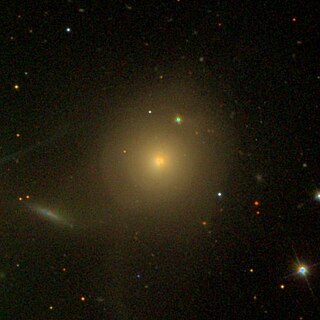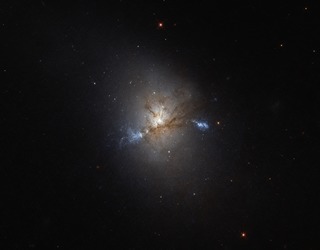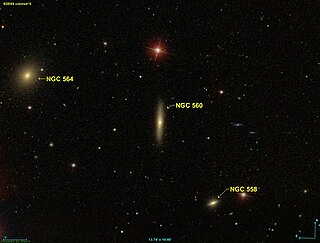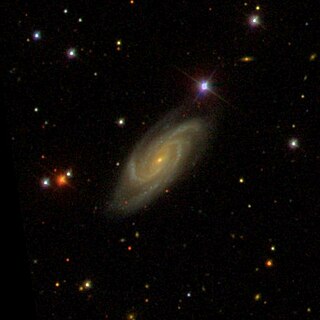
NGC 5614 is an unbarred spiral galaxy in the constellation Boötes. It is the primary member of the Arp 178 triplet of interacting galaxies with NGC 5613 and NGC 5615.

NGC 5613 is a lenticular galaxy in the constellation Boötes. It is part of the Arp 178 set of interacting galaxies, with NGC 5615 and NGC 5614.

NGC 467 is an unbarred lenticular galaxy in the constellation Pisces. It was discovered on 8 October 1785 by William Herschel.

NGC 155 is a lenticular galaxy in the Cetus constellation. It was discovered on September 1, 1886, by Lewis A. Swift.

NGC 160 is a lenticular galaxy in the Andromeda constellation. It was discovered on December 5, 1785, by William Herschel.

NGC 1222 is an early-type lenticular galaxy located in the constellation of Eridanus. The galaxy was discovered on 5 December 1883 by the French astronomer Édouard Stephan. John Louis Emil Dreyer, the compiler of the New General Catalogue, described it as a "pretty faint, small, round nebula" and noted the presence of a "very faint star" superposed on the galaxy.

NGC 1403 is a lenticular or elliptical galaxy in the constellation Eridanus. It was discovered in 1886 by Francis Preserved Leavenworth. It was thought to be a "very faint, extremely small, nebulous star" by John Louis Emil Dreyer, the compiler of the New General Catalogue.

NGC 485, also commonly referred to as PGC 4921 or GC 270, is a spiral galaxy in the constellation Pisces. It is located approximately 86 million light-years from Earth and was discovered on January 8, 1828 by astronomer William Herschel. It was later also observed by Heinrich d'Arrest and Herman Schultz. When NGC 485 was originally categorized in the New General Catalogue by John Louis Eil Dreyer in 1888, it was incorrectly described as a "considerably faint, pretty large, round, 8th magnitude star 3 1/2 arcmin to southwest".

NGC 5575 is a lenticular galaxy in the constellation Virgo. The object was discovered on May 8, 1864 by the German astronomer Albert Marth.

NGC 560 is a lenticular galaxy in the constellation Cetus. It is estimated to be about 250 million light-years from the Milky Way and has a diameter of approximately 150,000 light years. It is part of the Abell 194 galaxy cluster. NGC 560 was discovered on October 1, 1785 by the German-British astronomer William Herschel.

NGC 670 is a lenticular galaxy located in the Triangulum constellation about 165 million light years from the Milky Way. It was discovered by the German-British astronomer William Herschel in 1786.

NGC 850 is a lenticular galaxy in the constellation Cetus. It is estimated to be 300 million light-years from the Milky Way and has a diameter of approximately 130,000 ly.

NGC 890 is a lenticular galaxy in the constellation Triangulum. It is estimated to be 180 million light-years from the Milky Way and has a diameter of approximately 130,000 ly. NGC 890 was discovered on September 13, 1784 by Wilhelm Herschel.

NGC 813 is a lenticular galaxy in the constellation Hydrus. It is estimated to be 390 million light-years from the Milky Way and has a diameter of approximately 140,000 ly. NGC 813 was discovered on November 24, 1834 by the British astronomer John Herschel.

NGC 804 is a lenticular galaxy located in the Triangulum constellation about 231 million light-years from the Milky Way. It was discovered by the American astronomer Lewis Swift in 1885. This galaxy was also observed by the French astronomer Guillaume Bigourdan on December 24, 1897, and it has been added to the Index Catalogue under the symbol IC 1773.

NGC 939 is a lenticular or elliptical galaxy in the constellation Eridanus. It is estimated to be 241 million light-years from the Milky Way and has a diameter of approximately 80,000 ly. NGC 939 was discovered on October 18, 1835 by astronomer John Herschel.

NGC 535 is a lenticular galaxy in the constellation Cetus. It is estimated to be 222 million light years from the Milky Way and has a diameter of approximately 65,000 light years. The supernova SN 1988ad was observed near these coordinates. NGC 535 was discovered on October 31, 1864, by astronomer Heinrich Ludwig d'Arrest.

NGC 656 is a barred lenticular galaxy located in the Pisces constellation about 175 million light-years from the Milky Way. It was discovered by the Prussian astronomer Heinrich d'Arrest in 1865.

NGC 861 is a spiral galaxy in the constellation Triangulum. It is estimated to be 360 million light-years from the Milky Way and has a diameter of approximately 165,000 light-years. The object was discovered on September 18, 1865 by Heinrich d'Arrest.

NGC 551 is a spiral galaxy in the constellation Andromeda. It is estimated to be about 205 million light-years from the Milky Way. The object was discovered on 21, September 1786 by the German-British astronomer William Herschel.



















